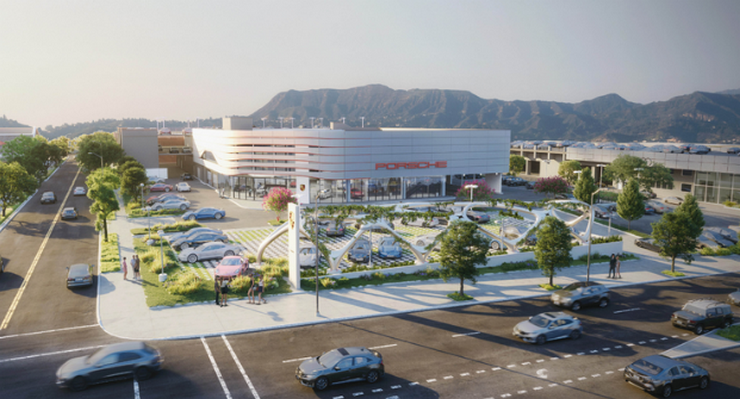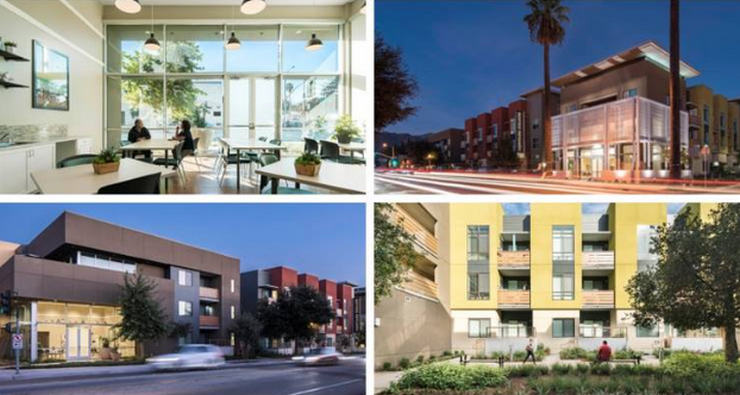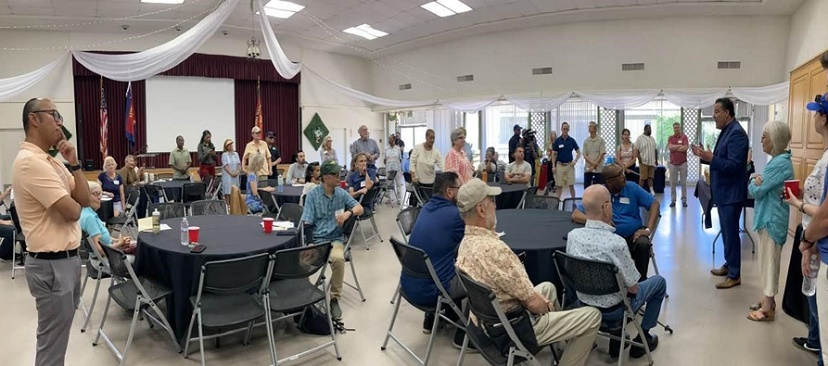
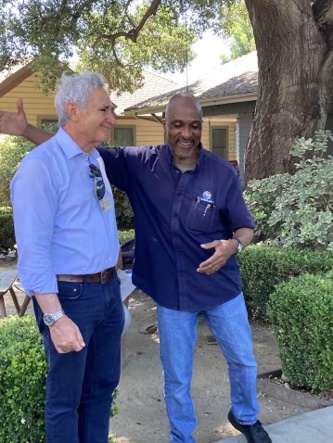 On July 15 Making Housing and Community Happen Affordable (MHCH), a Pasadena-based nonprofit, sponsored an Affordable Housing Tour Bus that was filled with 56 people eager to see for themselves over a dozen affordable housing sites in Pasadena.
On July 15 Making Housing and Community Happen Affordable (MHCH), a Pasadena-based nonprofit, sponsored an Affordable Housing Tour Bus that was filled with 56 people eager to see for themselves over a dozen affordable housing sites in Pasadena.
Thirty-six of the participants were mayors and city council members from eleven cities in the San Gabriel Valley: Arcadia, Alhambra, Baldwin Park. Claremont, Diamond Bar. Glendora, Monrovia, Pasadena, South El Monte, and W. Covina,
The rest were homeless service providers, community and religious leaders, and affordable housing experts.
As participants stood in the courtyard of Fair Oaks Court—a beautiful, affordable, craftsman-style condo development by Heritage Housing Partners, where Bruce now lives—he told them how rising rents pushed him out of his apartment where he’d lived for 18 years. He found himself living in the back room of a friend’s house for five years because he had “nowhere else to go.” Even though he worked full-time, he still couldn’t afford an apartment in Pasadena.
In 2020, he applied for a condo at Fair Oaks Court and to his great relief was accepted. His new home was affordable because he had to pay only 1% down and his mortgage payment was lower than a typical apartment.
“When this opportunity came by, I was thinking because for what I make, to live here in the city, and to be able to be a homeowner is a freaking miracle,” said Bruce. “If any of you have any questions about having this type of program in your city, don’t, because it’s saved my life. There are people out there in the workforce like me, that have nowhere else to go….they work 40 hours and there’s no place that they can afford. This place was a blessing, and I am very happy because it regenerated my life.”
This and other moving stories by people whose lives were transformed by affordable housing were shared during the tour. Cynthia Kirby, a woman who experienced homelessness for ten years and became housed over ten years ago thanks to Union Station Homeless Services, shared her story. Once she had stable housing, Kirby became sober, reunited with her daughter, earned a college degree, and now works for First Baptist Church of Pasadena.
Over 95% of those housed by Union Station stay housed for a year or more. “What ends homelessness,” said Anne Miskey, executive director of Union Station Housing Services, “is permanent supportive housing.”
The tour began at the Diane and John Mullin Salvation Army Hope Center, which opens this summer and provides studio apartments and supportive services for 65 unhoused individuals.
Pasadena City Manager Miguel Márquez greeted the participants on behalf of the City of Pasadena and took part in the tour.
“It was a pleasure to serve as the host city to show others the innovative things this community has been doing for many years now,” said Márquez. “Nothing is easy, especially taking on homelessness and affordable housing, both of which are deeply rooted in the inequitable distribution of wealth and income in our society. But with commitment and flexibility, there are many different ways to effectively address these issues. We must have seen more than a dozen projects. No two were alike, but all helped those in their time of greatest need, and all enjoyed broad community support. The tour made clear it can be done.”
During the tour, participants saw a variety of affordable housing types serving diverse groups with different needs: families, seniors, veterans, people with disabilities and mental illness, and those who have been chronically unhoused. The sites ranged in size from 14-story apartments like the Concord to Marv’s Place, a beautiful three-story Mediterranean-style villa for 19 formerly unhoused families.
Residents of affordable housing come from all ethnic backgrounds. Arcadia city council member (and former mayor) April Verdato was “surprised” by the ethnic diversity of the residents “including a sizable percentage of Asian Americans, particularly at the senior housing projects.”
Pasadena Housing Director Bill Huang and MHCH founding director Jill Shook provided commentary and answered questions for those on the tour. They dispelled myths by citing studies showing that affordable housing doesn’t decrease property values or increase crime. Quite the opposite. Affordable housing also must meet high design and environmental standards.
They explained that governments can also give preference to local residents and to local contractors and workers. Through this policy, Heritage Square North, a senior affordable housing facility that the group toured, brought over $6 million in investment to the city.
While at Westgate Apartments, a deluxe apartment complex with 340 units that have been converted to affordable workforce and low-income housing, Shook and Huang explained that Pasadena’s inclusionary policy requires that new developments must set aside 20% of units as affordable, pay an in lieu fee, or build the units off-site. This policy (which MHCH helped to be passed) has created over 1000 units of affordable housing, at no cost to the city.
“I left the bus tour feeling inspired and optimistic about solving homelessness,” said Jed Leano, former mayor of Claremont. “I saw what the city of Pasadena was able to do to address its housing and homelessness needs, and I feel confident that other cities can work to build more affordable housing for working-class families, and supportive housing, for individuals and families experiencing homelessness.”
Not all participants were convinced, however. Some felt that what they heard and saw was too good to be true, or had been “cherrypicked.” Others felt that people needed to “clean up their act” before being housed even though studies show that people who have lived on the street need the stability of supportive housing to deal with their issues. This model, called “Housing First,” is considered the best practice to end homelessness.
After the tour, participants gathered at the Salvation Army for a luncheon and a workshop on how congregations can have affordable housing built on their underutilized land, as the Salvation Army has done.
Before the workshop, Mayor Gordo welcomed everyone on behalf of the City of Pasadena and was joined by Pasadena Councilmembers Jess Rivas and Jason Lyon. Mayor Gordo called on the cities of the San Gabriel Valley to work together to address the homeless and housing crisis.
Housing Director Bill Huang gave a presentation explaining how the Salvation Army Hope Center came about. Initially, he explained, the Salvation Army wanted to build only a food pantry on this site, but he showed them that their site could be developed for supportive housing. The Salvation Army was keenly interested, formed an experienced development team, and was able to raise the funds through various sources to build this $35-million-dollar project.
Not all congregations have the resources to be developers, like the Salvation Army. Phil Burns, principal planner for The Arroyo Group, explained how the Congregational Land Committee (CLC) of MHCH helps congregations to envision what kind of affordable housing they want to build, what is feasible, and how to partner with a reputable developer who will find the funding and provide the church with a fair return for their land.
Over 75 churches have approached the CLC but about a third of them don’t have the right zoning to build affordable housing. That’s why MHCH is part of a coalition of 300 organizations to pass SB 4, a state bill that would rezone religious and nonprofit college land statewide for affordable housing.
“Churches have always felt it was their mission to help the marginalized with food and clothing,” said Burns. “Building affordable housing on their underutilized land is good stewardship, a way to put into practice Jesus’ commandment to ‘love your neighbor.’”
This is certainly the case with the Diane and John Mullin Salvation Army Hope Center, as their website makes clear:
“For more than 30 years, The Salvation Army in Pasadena has been serving the community well by operating a food pantry and other critical social service programs—while doing so in a small, multi-room, and inefficient commercial office space. Still, there was always a dream for a much bigger impact by building a new facility to benefit those in need in the Pasadena area. Because of the Mullins, the City of Pasadena, and the support of our dear community leaders and friends, this dream is becoming a reality.”
Below: Bus tour photo with Bill Huang on the left. Phil Burns presenting about affordable housing on religious land.







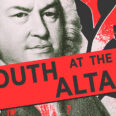





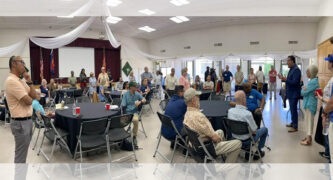

 3 comments
3 comments
